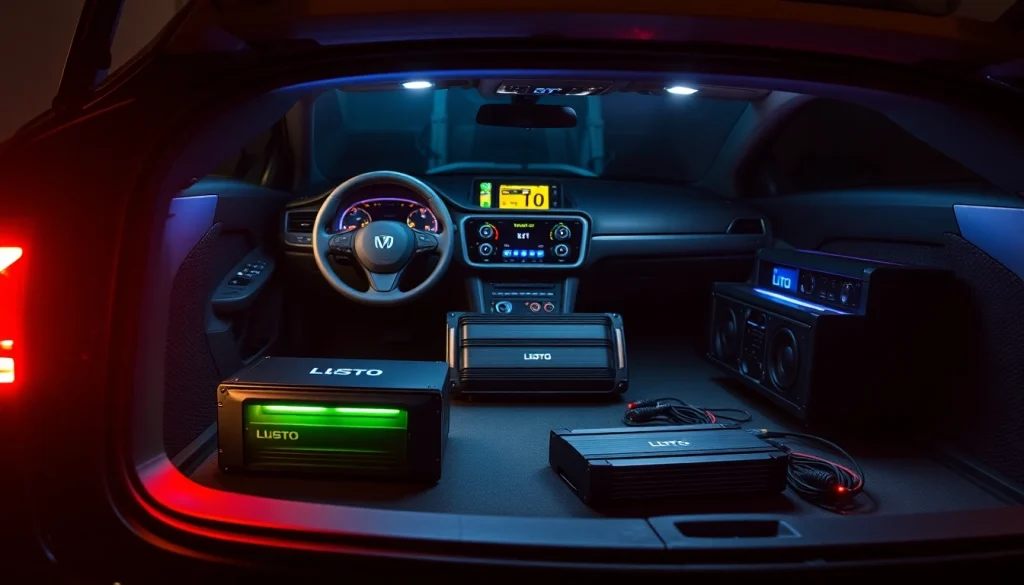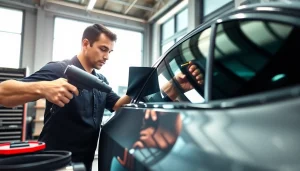Maximize Your Car Audio Experience with Premium LTO Lithium Battery and Amplifier Solutions

Understanding Car Amplifiers
What Are Car Amplifiers?
Car amplifiers serve as crucial components in automotive audio systems, boosting the power of your audio signals to achieve higher sound quality and volume. Unlike factory-installed options, which often lack adequate power and fidelity, aftermarket car amplifiers can significantly enhance your listening experience. By converting low-level signals from a head unit into a high-level output, amplifiers enable your speakers to produce clearer, more dynamic sounds.
Types of Car Amplifiers
There are several types of car amplifiers designed for specific audio setups:
- Class A Amplifiers: Known for their excellent audio quality, Class A amplifiers are characterized by high fidelity at lower power levels. They are often used in high-end sound systems but can be inefficient.
- Class B Amplifiers: These amplifiers improve efficiency by only amplifying the positive or negative side of the audio signal but can introduce distortion.
- Class AB Amplifiers: A hybrid of Class A and Class B designs, Class AB amplifiers offer a balance between sound quality and efficiency, making them popular for car audio enthusiasts.
- Class D Amplifiers: Exceptionally efficient, Class D amplifiers use pulse-width modulation to provide powerful output with minimal heat generation. They are ideal for modern car audio systems and high-power setups.
- Mono Amplifiers: Designed specifically to power subwoofers, mono amplifiers focus on delivering high power at low frequencies for deep bass.
- Multi-Channel Amplifiers: These are versatile units that can power multiple speakers simultaneously, typically offering two to six channels of output.
Benefits of Using a Car Amplifier
Utilizing a car amplifier in your audio system offers numerous benefits:
- Improved Sound Quality: Amplifiers enhance the overall clarity and detail of the audio, enabling you to enjoy music as it was intended.
- Higher Volume Levels: With increased power, amplifiers allow you to play audio at higher volumes without distortion.
- Better Speaker Control: Ample power helps speakers perform optimally, preventing damage due to under-powering.
- Customization: Using separate amplifiers for different speakers gives you control over the outputs, enabling tailored adjustments based on personal preferences.
The Role of LTO Lithium Batteries in Audio Systems
What is an LTO Lithium Battery?
LTO, or Lithium Titanate Oxide, batteries represent a breakthrough in battery technology, specifically designed for high-discharge applications such as car audio systems. Unlike traditional lead-acid batteries, LTO batteries offer faster charging times, longer cycle life, and superior voltage stability. The unique chemistry of LTO cells allows them to tolerate deep discharges, making them perfect for audio systems that require rapid bursts of energy.
Advantages of LTO Lithium Batteries
When integrating LTO lithium batteries into your car audio system, the benefits become immediately apparent:
- Rapid Charging: LTO batteries can be charged in a fraction of the time compared to lead-acid alternatives, minimizing downtime.
- Long Cycle Life: With up to 20,000 charge cycles, LTO batteries outlast traditional batteries, offering better longevity and value over time.
- Exceptional Voltage Stability: LTO batteries maintain consistent voltage levels under load, preventing the dreaded voltage sag that can compromise sound quality.
- Compact Design: These batteries are lighter and more compact, allowing for flexible installation options in various vehicles.
- Environmentally Friendly: LTO technology does not involve toxic materials, making it a more sustainable choice for powering vehicle audio systems.
Choosing the Right LTO Battery for Your Car Amplifier
Selecting the proper LTO lithium battery is essential for optimizing your car audio system. Several factors to consider include:
- Discharge Rate: Depending on your amplifier’s power needs, choose an LTO battery with a matching discharge rate. Options include 3AH (75C discharge), 6AH (80C discharge), and 20AH (35C discharge) models.
- Capacity: Ensure the battery capacity aligns with your usage patterns. Higher capacity batteries allow for prolonged performance during extended listening sessions.
- Physical Size: Confirm the dimensions of the LTO battery to ensure a proper fit in your vehicle while considering installation accessibility.
- Durability: Select a battery designed for high-performance audio systems to withstand the demands of powerful amplifiers.
Integrating LTO Batteries with Car Amplifiers
Optimal Wiring Techniques
Proper installation is crucial for maximizing the performance of your LTO battery and car amplifier. Follow these guidelines to ensure optimal results:
- Use Quality Wiring: Invest in high-quality power and ground wires to minimize resistance. A heavy gauge wire (like 4 AWG or heavier) is typically recommended for high-power applications.
- Correctly Connect Terminals: Ensure all connections between the battery and amplifier are tight and secure. Loose connections can lead to voltage drops.
- Fuses and Circuit Breakers: Incorporate fuses and/or circuit breakers into your wiring to protect your system from voltage spikes and potential fires.
- Maintain Short Cable Runs: Keep cables as short as possible. Additional length can introduce resistance that impairs audio performance.
Power Management Strategies
To effectively manage power in your car audio system, consider these strategies:
- Monitor Voltage Levels: Use a voltage meter to keep an eye on your battery’s voltage levels, ensuring the system is operating within safe parameters.
- Install a Capacitor: For systems with high demands, an audio capacitor can help by storing surplus power for peak demands, reducing strain on the battery.
- Adequate Cooling: Ensure that your amplifier and battery have ample cooling. Overheating can lead to inefficiencies and potential component failure.
Testing System Performance
After integrating your LTO battery with your car amplifier, testing is vital to ensure everything is operating harmoniously:
- Subwoofer Performance: Check your subwoofer’s output by playing audio with strong bass lines. Adjust settings on your amplifier for the best balance.
- Clipping Tests: Play your audio at maximum volume while observing for distortion. If distortion occurs, reduce volume and adjust amplifier settings.
- Check Voltage Drops: During peak demand, monitor voltage levels to ensure they remain consistent. Significant drops indicate issues that require attention.
Real-World Applications and Customer Builds
Case Studies of Successful Builds
Many car audio enthusiasts have achieved outstanding results with LTO battery technology. Here are a few examples:
- Custom SUV Build: A customer installed a 20AH LTO battery alongside a Class D amplifier, accomplishing crystal-clear audio and robust bass suitable for outdoor festivals.
- Performance Vehicle: A competition-level SPL build utilized multiple 6AH LTO batteries for breathtaking output during events, demonstrating the capabilities of LTO batteries in real-world applications.
Feedback and Testimonials from Customers
Customer satisfaction is a testament to the effectiveness of LTO technology. Here are snippets from actual user experiences:
“I upgraded my audio system with an LTO battery and couldn’t believe the difference in sound quality and power!”
“The rapid charging capabilities of the LTO battery have made a noticeable difference, especially during long drives.”
Visual Showcase of Installations
For an inspiring visualization of successful installations, explore our car amplifier portfolio showcasing various setups by customers who integrated LTO batteries with impressive results.
FAQs About Car Audio Batteries and Amplifiers
Common Questions and Answers
Addressing common questions about car audio systems helps clarify the benefits and usability of LTO batteries and amplifiers:
- Q: Can I use an LTO battery with any car amplifier?
A: Yes, as long as the specifications and discharge ratings align with the amplifier’s requirements. - Q: How do I know what size battery I need?
A: Assess your amplifier’s power requirements and select a battery with a compatible capacity and discharge rate. - Q: What maintenance is required for LTO batteries?
A: Regularly check connections and voltage, and ensure the battery is kept dry and properly ventilated.
Troubleshooting Tips
If you encounter challenges with your car audio system, consider these troubleshooting tips:
- Audio Distortion: Check for loose connections or clipping in your amplifier settings.
- Battery Not Charging: Inspect wiring and ensure that your charging system is functioning correctly.
- Weak Sound Output: Verify that your amplifier’s settings are optimized for your specific setup.
Contacting Support for Assistance
If issues persist or you have further questions, reach out to our support team for guidance. Our team is committed to providing help as well as advice tailored to your unique needs.







